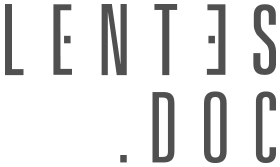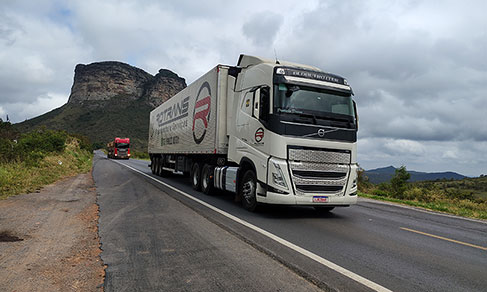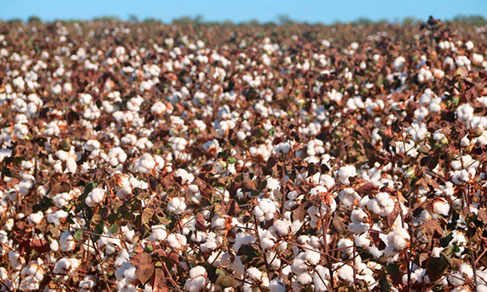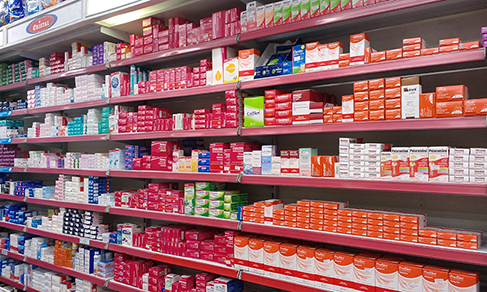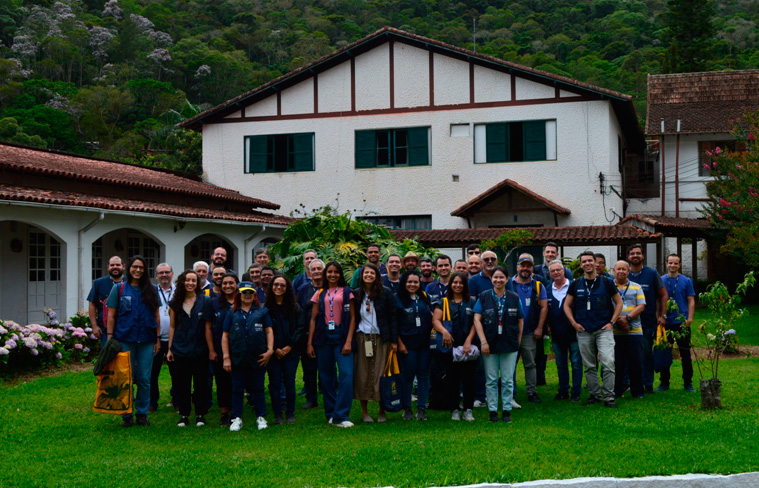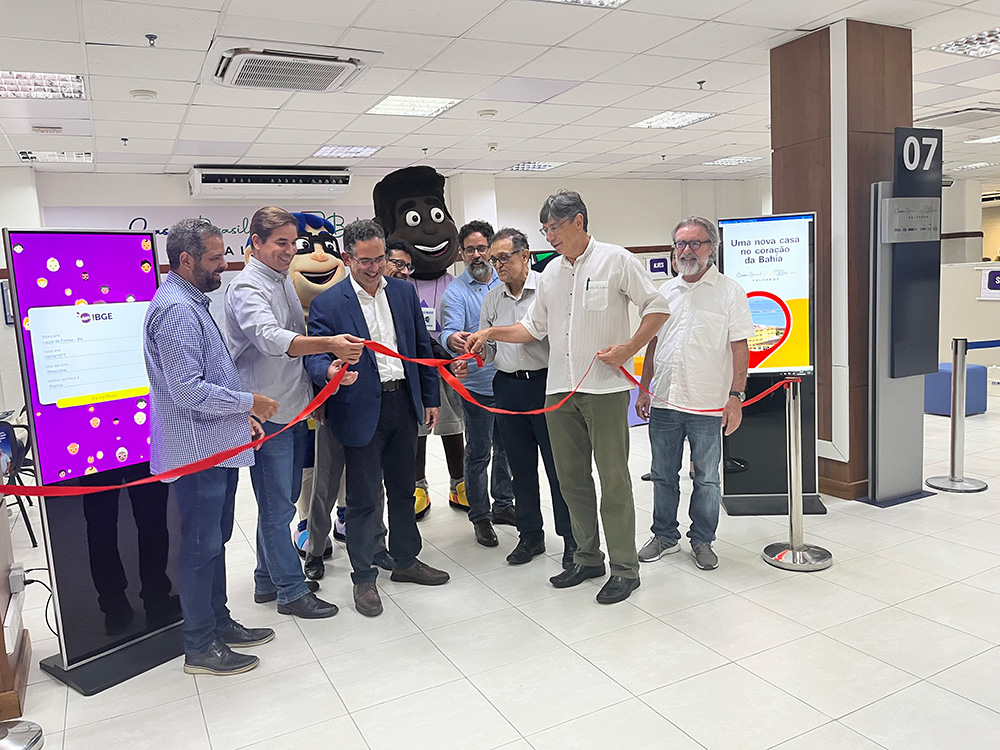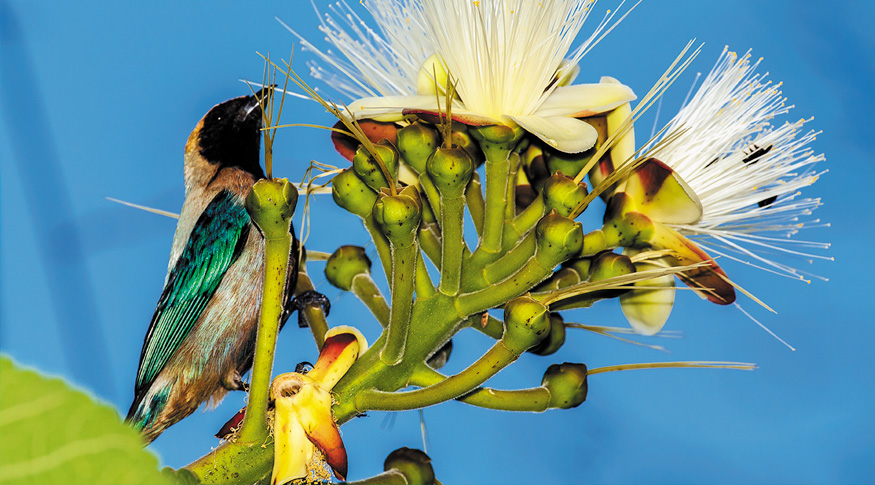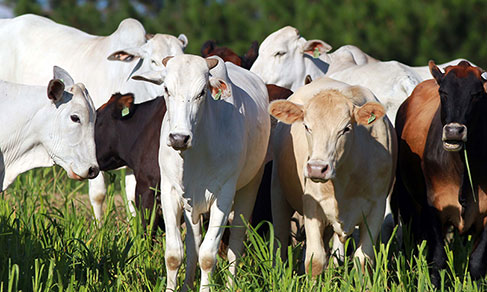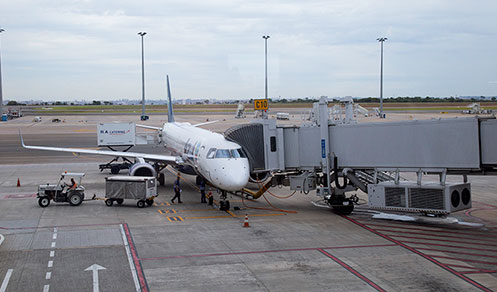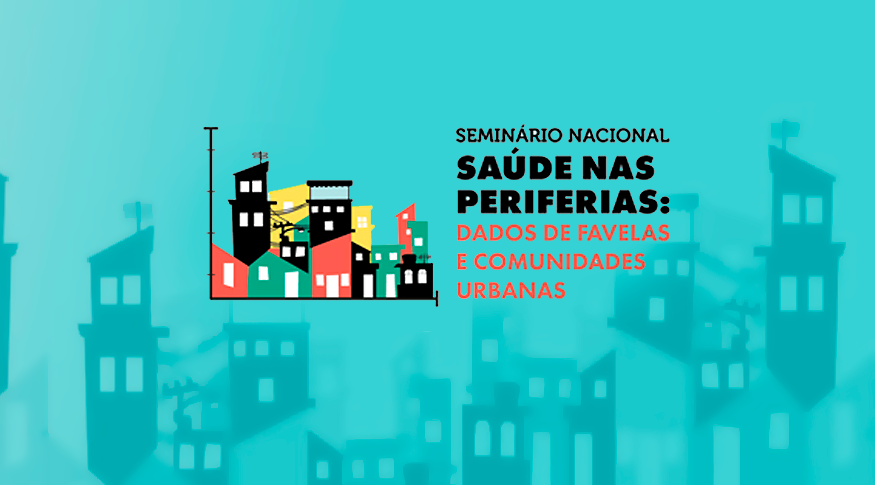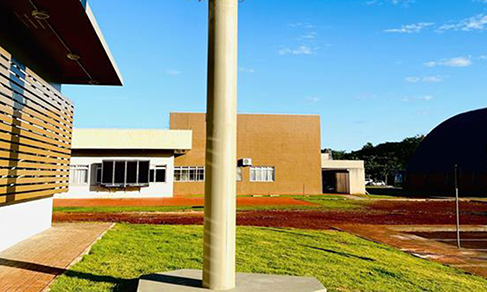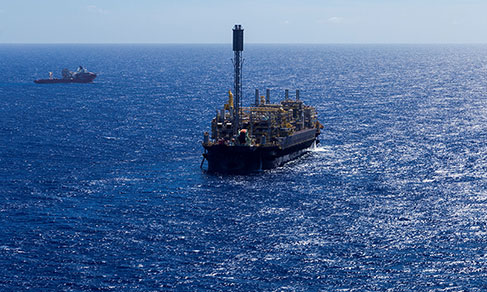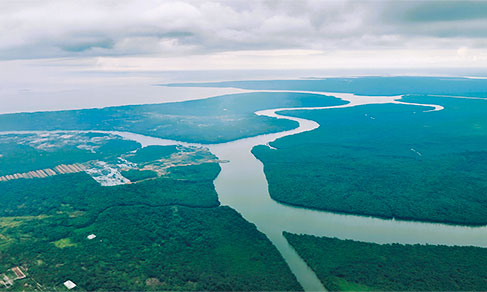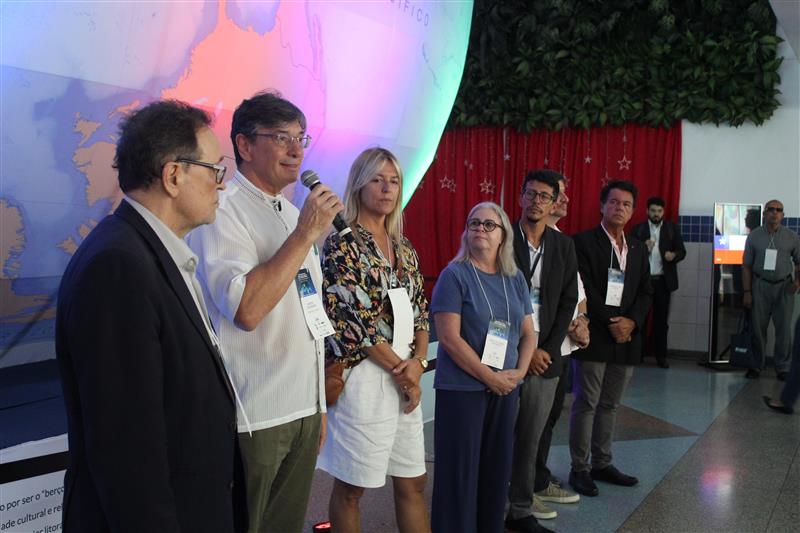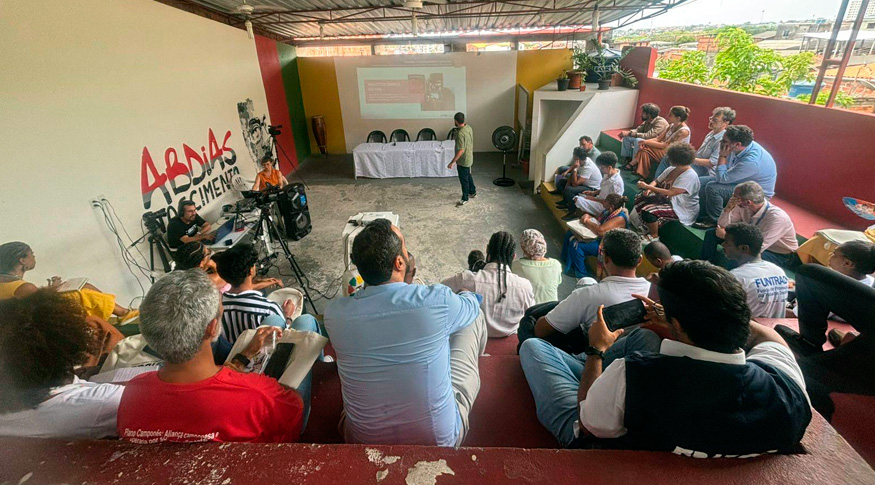Environment
Animal pollination contributes, on average, with 16.14% of value of Brazilian agricultural production
July 17, 2025 10h00 AM | Last Updated: July 21, 2025 03h34 PM
Highlights
- The contribution of animal pollination to the Brazilian agricultural/extractive value of production in 2023 is between 5% and 25% of the total, considering the minimum and maximum values of the Pollinator Contribution Indicator in the Value of Production. In 2023, the average value of the index was 16.14%, growing in relation to 1996 (14.4%).
- Considering the mode of production for temporary crops, the average indicator changed from 7.3% in 1996 to 12.0% in 2023. It changed from 36.4% to 38.7% in the permanent ones.
- Extractive production was the modality in which the contribution of pollinators mostly grew in proportional terms in the period analyzed, leaving from 21.8% in 1996 to 47.2% in 2023.
- In 2023, nearly 19% of the municipalities had more than one quarter of their value of production impacted by the action of pollinator animals. It had been 15% in 1996.
- More than half (52.2%) of 67 products investigated in PAM depended, in some degree, on animal pollination. Among the temporary crops, that rate was 31.2% and, among the permanent ones, it hit 71.4%. For the products from extractivism investigated by PEVS, 39.3% benefited from animal pollination.
- The harvested area of the Slight class of dependency on pollination registered the biggest increase in the time series of the survey, changing from 39% in 1975 to 53.5% in 2023. On the other hand, those Non-dependent lost share from 53.4% in 1975 to 43.8% in 2023.
- Among the temporary crops, nearly 54% of the harvested area was occupied by products with Slight dependency and 45%, by Non-dependent ones in 2023.
- Among the permanent crops, the Slight class of dependency occupied 41.2% of the harvested area in 2023. The products of the Essential class of dependency represented 20.5% of the area in 2023.
- Concerning the quantity produced, products that depend on pollination represent 17.6% of the quantity produced by the Brazilian agriculture in 2023.
- In extractivism, the quantity produced in Non-dependent products (55.6%) prevailed, though with high percentages of the Essential (12.9%) and High (28.4%) classes, which, together, hit 41.2% of the total quantity in 2023.
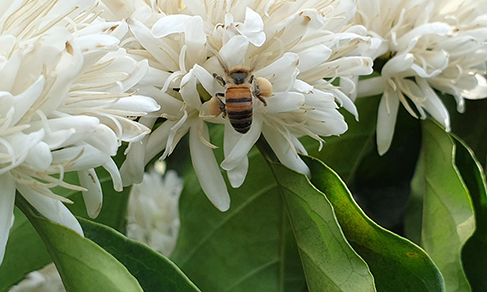
IBGE´s experimental study estimates the contribution of animal pollinators, like bees, for the Brazilian agricultural and extractive value of production. - Picture: Renata Kelly da Silva/EMBRAPA
The contribution of animal pollination to the Brazilian agricultural/extractive value of production in 2023 is between 5% and 25% of the total, considering the minimum and maximum values of the Pollinator Contribution Indicator in the Value of Production. This year, the average value of the index was 16.14%, growing in relation to 1996 (14.4%), the first year of the time series. Released today (17) by the IBGE, the experimental study "Contribution of Pollinators to the Brazilian Agricultural and Extractive Production 1981-2023" investigated the amount produced, area harvested and value of production of crops that have different levels of dependency on the action of animal pollinators, like bees, butterflies, beetles, bats, etc. highlighting their time, regional and municipal changes. Data from the Municipal Agricultural Production (PAM) and from Forestry Activities (PEVS) have been used.
The Pollinator Contribution Indicator in the Value of Production represents the participation of crops dependent from animal pollination in relation to the total produced, taking into account the different degrees of dependency on pollination of each species of plant. It is calculated through the weighting of the value of production of each product by its degree of dependency on pollination and reflects the distribution of the products dependent on pollination and their participation in the total value of production in each geography. The bigger this indicator, the bigger the estimated contribution of animal pollination.
"Future analyses incorporating estimates of the supply of pollinators according to the characteristics of landscapes will allow to advance in the estimates of the value of this service in the scope of the System of Economic-Environmental Accounts," explains Leonardo Bergamini, an analyst of the IBGE´s Division of Environment in charge of the study.
Among 89 products analyzed in the study, 48.3% depend, in some degree, on animal pollination, being more significant in permanent and extractive crops, which are more dependent on this process. Pollination consists of the transference of pollen between the male and female parts of flowers, enabling the fertilization and reproduction through the production of fruits and seeds. This process can be mediated by agents like water, wind and gravity (abiotic pollination) or carried out by animals (biotic pollination).
Considering the modes of production, the indicator was 12.0% for temporary crops and 38.7% for permanent ones in 2023. On the other hand, the value of production of the extractivism received a contribution of 47.2%. Extractive production was the modality in which the contribution of pollinators mostly grew, leaving from 21.8% in 1996. For temporary crops, the indicator was 7.3% in 1996 and, for permanent ones, 36.4%.
The products of temporary crops are the major determinants of the patterns observed for Brazil, since they occupy a larger portion of the harvested area, surpassing the permanent and extractive productions combined. However, a major part of temporary products is independent from animal pollination. Among the temporary products, a growth trend of the contribution of pollination has been observed along the period of analysis, even surpassing 20% in the most recent years, if considering the superior limit of the dependency values attributed to each crop.
"Pollination significantly influences the value of agriculture and extractive production in Brazil. However, the increase of the dependency of the crops in relation to this process contrasts with the reduction of the population of pollinators. Pollinating species suffer a number of threats, like loss of habitat, intensive use of pesticides, diseases, climate changes, invasive species, etc. Overcoming these challenges requires investments in research and strategies that guarantee the continuity of this service," explains Bergamini. He reminds that crops with lower dependency rates can also have their production and quality significantly increased through the action of pollinators.
Major temporary crop in Brazil, soybean barely depends on pollination
Although the average values of the contribution of pollination to the value of production have been, in general, between 10% and 20%, there are differences, depending on the composition of the crops prevailing in each region. Soybean, for instance, appeared among the five main products dependent on pollinators in all the regions.
Even with a slight dependence on pollinators, due to the volume produced and value of production, the expansion of soybean beyond the traditional cropping areas, in the south of Brazil, had two consequences: on the one hand, it contributed to the increase of the area occupied by crops that depend on pollinators and, on the other hand, it replaced crops with higher dependency on these agents, reducing the participation of products associated to animal pollination, especially those with lower trade value.
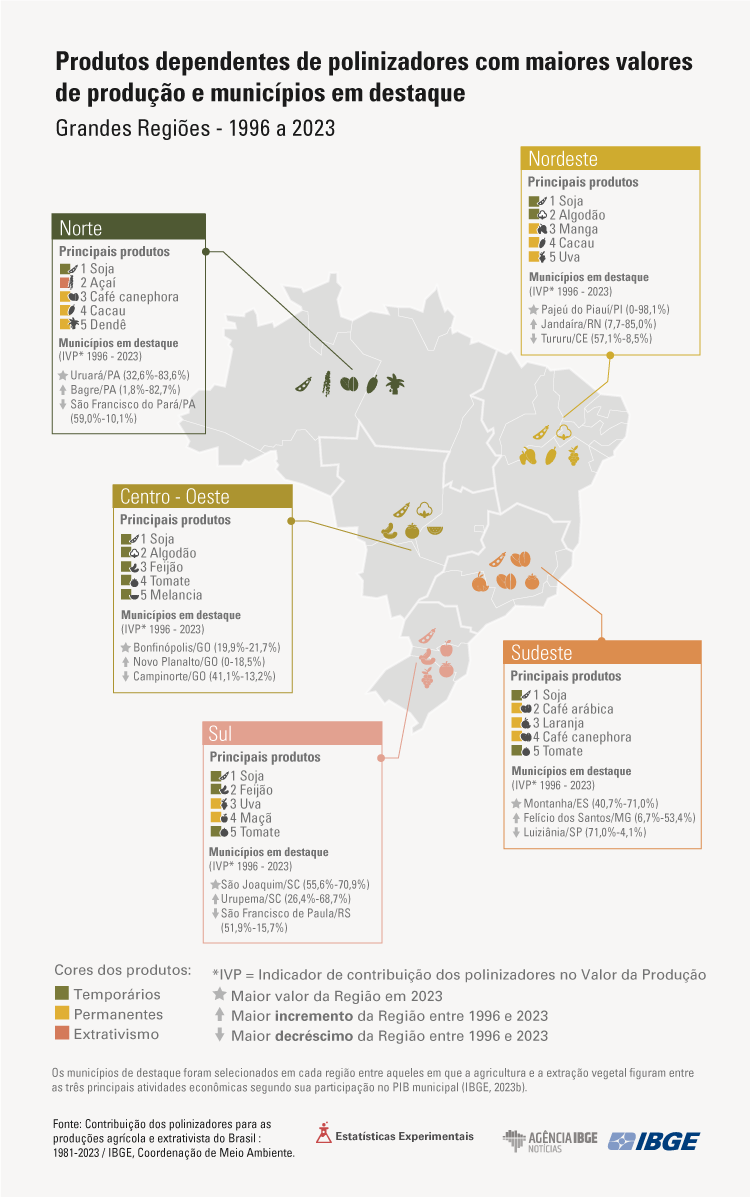
In the North, the contribution of the pollinators to the value of production of temporary products was slightly higher than 10% in recent years. Concerning the value of production of permanent crops, this index surpasses 60% since 2020. The main product of temporary crop was soybean (slight dependency). Regarding permanent crops, açaí (high) was the main product of this cropping category, being the states of Pará and Amazonas the major producers. Coffea canephora and cocoa came next, with an important participation in the agricultural production. In the wild crop harvesting, the dependency on pollination stayed around 80%, being açaí (high) the main product of this category in the region.
In the Northeast, where permanent crops highly dependent on the action of pollinators prevail, the contribution was close to 50% along the period analyzed. Among the temporary crops dependent on animal pollination, soybean and cotton (slight) stood out as they significantly impact on the value of production, due to the high production volume and economic value. Concerning the permanent crops, fruits like mango (high), cocoa (essential) and grapes (low), among others, are relevant to the regional economy and depend on animal pollination to guarantee quality and quantity. Although no product has been ranked among the five best products in the region, babaçu (slight), açaí (high) and umbu (essential) stood out in the wild crop harvesting.
In the Southeast, the major temporary crops, like soybean and tomatoes, also have a slight dependency on animal pollination, resulting in a general value of the indicator around 16% along the period analyzed. On the permanent crops side, with a contribution of 32.5% in 2023, it is worth mentioning very relevant products for the national economy and foreign market: the two species of coffee, canephora (high) and arabica (slight), and oranges (slight). And, in the wild crop harvesting, pequi stands out, a product essentially dependent on pollination, mainly accomplished by bats. In this production mode, the value of the contribution hit 75.1% in 2023.
Among the temporary crops in the South, three products of slight dependency stand out: soybean, bean and tomatoes, with an indicator of 11% in 2023. Besides grapes (low), apple stands out among the permanent crops, as it shows a high dependency on animal pollination and it is one of the main products responsible for the indicator of 31.4% in 2023, being the states of Santa Catarina and Rio Grande do Sul the biggest producers in Brazil. The main products from wild crop harvesting in the region (yerba mate and pine nut) do not depend on pollination, resulting in null values of contribution.
On the other hand, the contribution of pollination in temporary crops in the Central-West remained around 15% along the time series. Only temporary products appear in the list of the five main products of the region, a scenario that was not repeated in the other four regions. Despite the slight dependency on pollinators, soybean and cotton show a high volume of production, significantly contributing to the total value associated to pollination in the region. Although the products from wild crop harvesting are not among those with a high value of production, those depending on pollination, like castanha-do-pará and pequi (both with an essential dependency), contribute with more than 95% of the total produced in this production mode. Unlike other regions, the levels of dependency on pollination of the permanent crops in the Central-West were similar to those of the temporary crops.
More and more municipalities depend on pollination for agricultural and extractive production
Most Brazilian municipalities benefit from pollination for the agricultural and extractive production, and this number has been growing. Between 1996 and 2023, the proportion of municipalities with a contribution from pollination in the value of production above 5% increased by nearly 6 percentage points. The Northeast, a producer of fruits with high dependency on pollinators, was the region in which this movement has been more evident. Moreover, the survey showed that even crops less important in the national scenario might have a strategic relevance for the economy of certain municipalities.
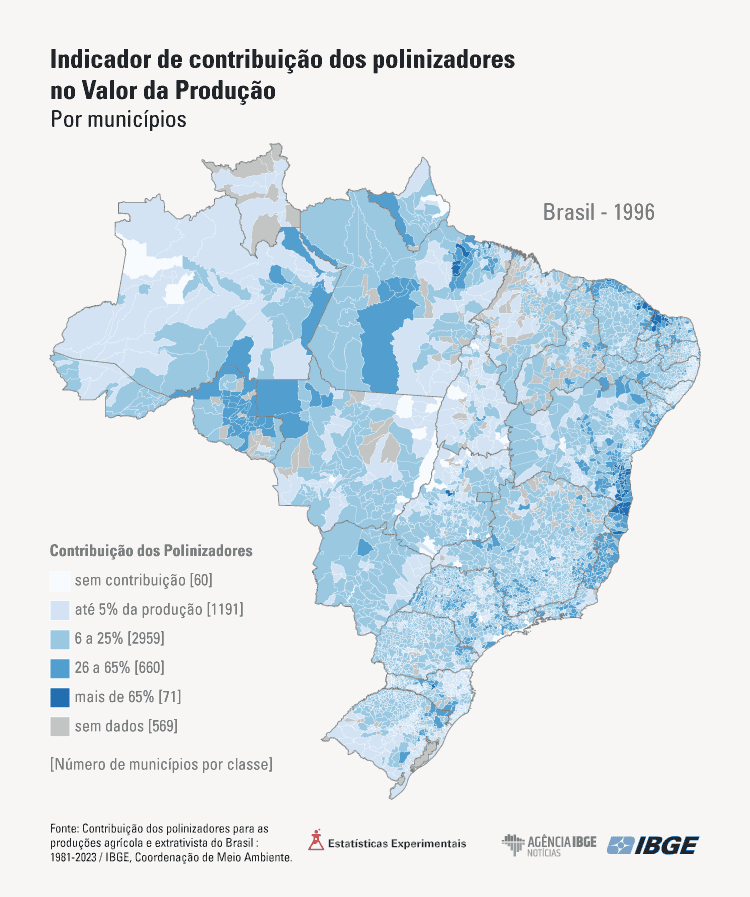
Along the period analyzed, there were municipalities in which the dependency on pollination remained high, others in which pollination became more important over time, and also those in which the importance decreased.
"It is worth highlighting that the species that act as pollinators are not only responsible for this service. They are important to the reproduction not only of cultivated plants, but also of wild plants, being key to the maintenance of the ecosystems as a whole, from which we obtain benefits like air and water purification, among other things," notes Bergamini.
More than half of Brazilian agricultural products depend on animal pollination
According to the study, 52.2% of 67 products investigated in PAM depended, in some degree, on animal pollination. Among the temporary crops, that rate was 31.3% and, among the permanent ones, which are mostly fruits, it hit 71.4%.
|
Classification of PAM products by type of crop and by class of dependency on animal pollinators (percentage and number of products in each class are shown) |
|||
|---|---|---|---|
| Dependency | % Total (n) | %Temporary (n) | % Permanent (n) |
| Total with dependency | 51.5 (35) | 31.2 (10) | 71.4 (25) |
| Essential | 10.4 (7) | 3.1 (1) | 17.1 (6) |
| High | 19.4 (13) | 9.4 (3) | 28.6 (10) |
| Slight | 16.4 (11) | 15.6 (5) | 17.1 (6) |
| Low | 6 (4) | 3.1 (1) | 8.6 (3) |
| Non-dependency | 46.3 (31) | 68.8 (22) | 25.7 (9) |
| Unknown | 1.5 (1) | 0 (0) | 2.8 (1) |
|
Sources: 1. Siopa et al. 2024. 2. Wolowski, et al. 2019. 3. Klein et al. 2007. 4. Sabino et al. 2022. 5. Queiroga et al. 2023. 6. Fronza et al. 2018. 7. De Medeiros et al. 2019. 8. PAM. |
|||
The period analyzed, from 1975 to 2023, registered a significant rise in the Brazilian agricultural production, mainly driven by the growth of temporary crops, which grew both in area and in quantity. Although the area has not changed a lot, the quantity produced increased among the permanent crops.
With the expansion of soybean, Slight class surpasses half of total harvested area
In 2023, more than half of the harvested area was occupied by products of Slight dependency. That class recorded the highest increase in the time series of the survey, changing from 39% in 1975 to 43.4% in 2000 up to 53.5% in 2023. No dependent crops also reported a significant increase in the area, though, in percentage terms, its occupation decreased from 53.4% in 1975 to 43.8% in 2023.
This pattern is mainly related to the expansion of products from temporary crops, which occupy most of the cropped area, especially soybean. Although the No Dependency class represents 68.8% of the products from temporary crops, in 2023 nearly 54.2% of the harvested area was occupied by products of Slight dependency and 45.5%, by Non-Dependency ones. In 1975, these classes represented, respectively,
32.3% and 65.8%.
Among five products from temporary crops with a high area occupation, two of them belong to the Slight class of dependency (soybean and bean) and three of them belong to the No Dependency class (corn, sugarcane and wheat).
Among the permanent crops, the Slight class of dependency occupied 41.2% of the harvested area in 2023, though it corresponds to only 19.4% of the products, having coffea arabica, oranges and coco-da-baia as the most significant products. It dropped in relation to 1975, when that class occupied 76.5% of the cropping area of permanent crops. Producers of the Essential class of dependency represented 8.7% of the permanent crops in 1975 and occupied 20.5% of the area in 2023, highlighting cocoa and cashew as the largest cropping areas.
Comparing the distribution of the cropping area of temporary and permanent agricultural products in 2023, it is noticed a low concentration in few products and a high diversity in the dependency rates among the permanent ones.
Products that depend on pollination represent 17.6% of the quantity produced by the Brazilian agriculture
In 2023, No dependency products were responsible for 82.4% of the total quantity produced in Brazil. In contrast, crops of Slight dependency represented 15.9% of the quantity produced, whereas the Low, Essential and High classes added up to 1.6%. The proportion of No dependency products dropped in relation to 1975, representing 85.4%, and those of Slight class increased (12.6%).
"The average dependency rates in Brazil are, to a great extent, influenced by temporary crops, since they prevail both in area and in volume of production," highlights the manager.
Among the temporary crops, those that do not depend on pollinators are responsible for most quantity produced (85%). The products of Slight class represent 14.8%.
Among the permanent crops, a higher distribution of types of dependency classes is noticed, prevailing the Slight dependency class (44.7%), as observed in the harvested area. The High (20.1%) and No dependency classes (18.5%) are very representative, especially in the most recent period.
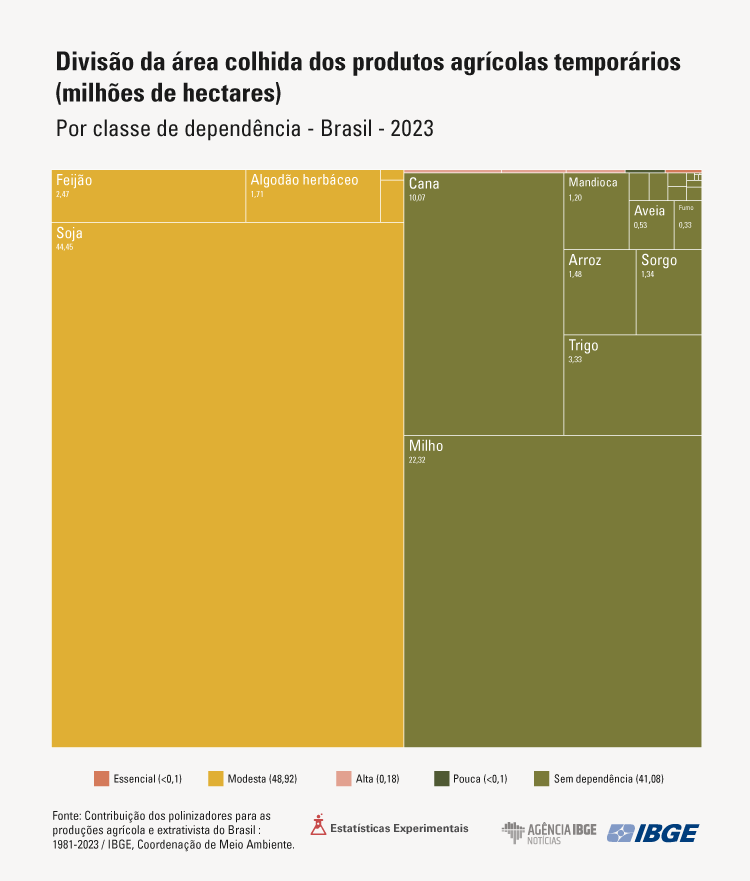
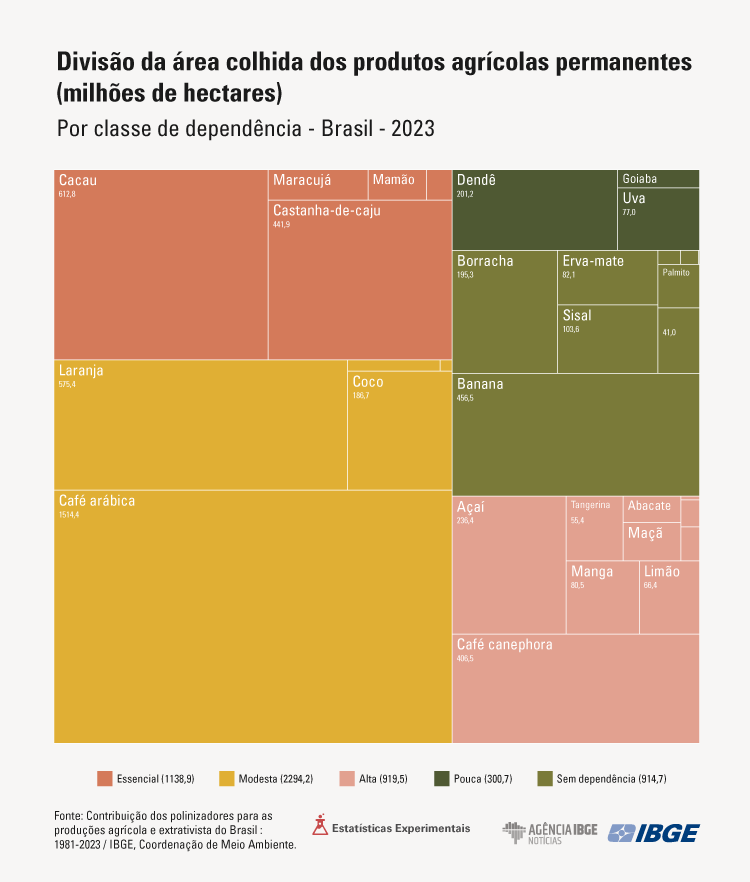
Division of the harvested area and the quantity produced of the products of permanent, temporary and wild crop harvesting by class of dependency
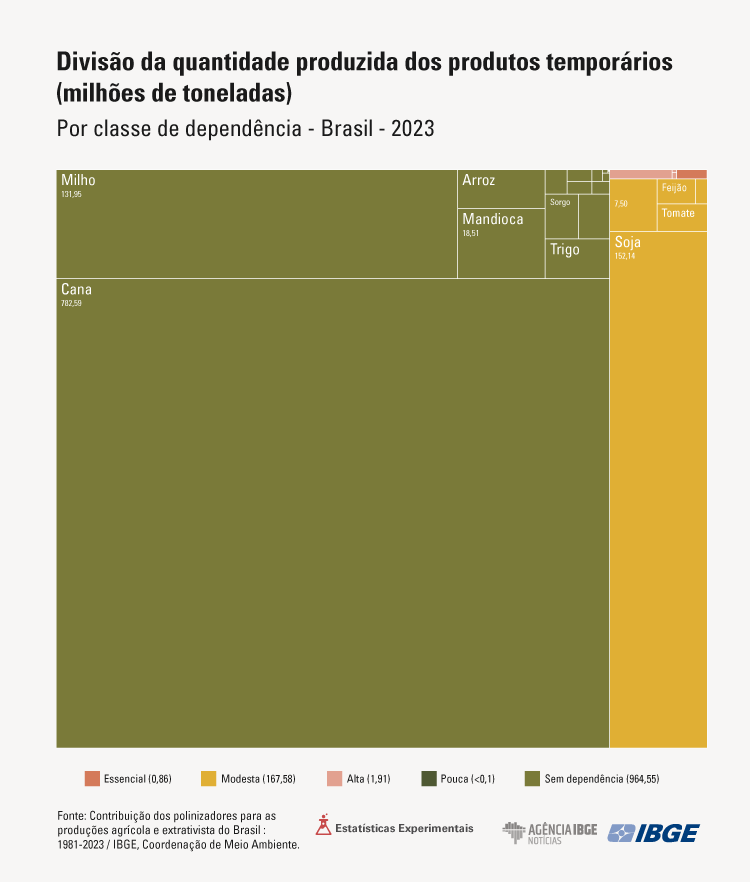
Division of the harvested area and the quantity produced of the products of permanent, temporary and wild crop harvesting by class of dependency
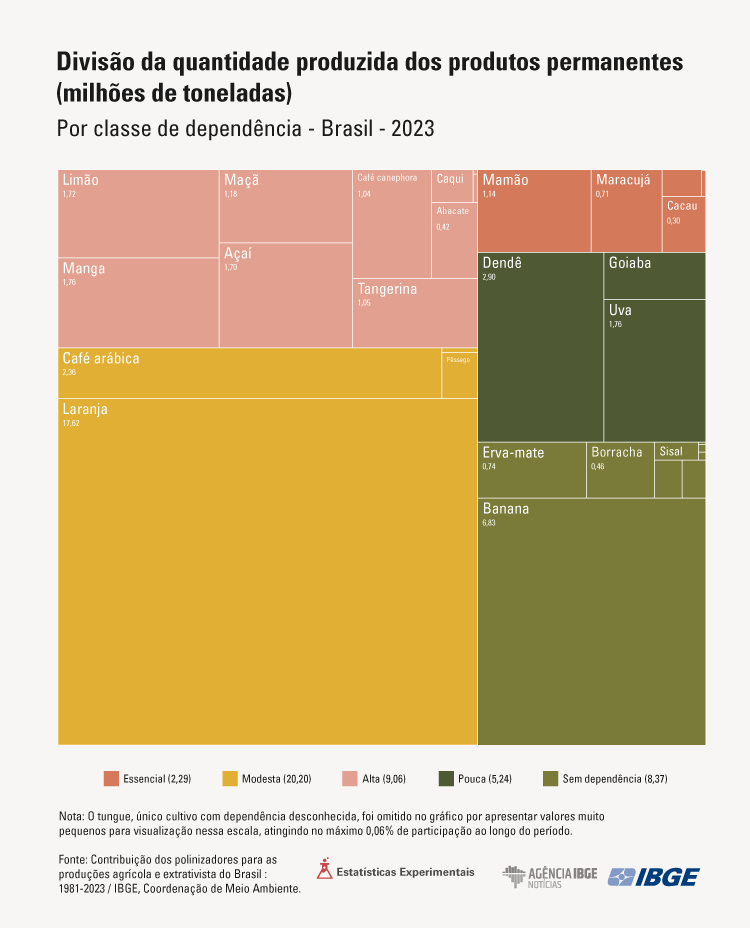
Division of the harvested area and the quantity produced of the products of permanent, temporary and wild crop harvesting by class of dependency
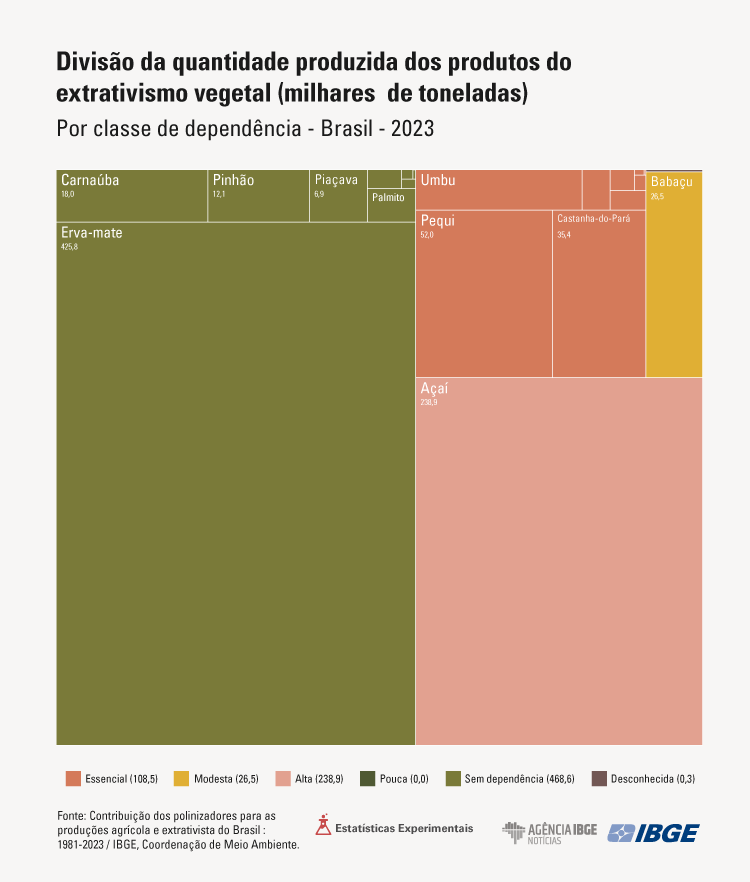
Division of the harvested area and the quantity produced of the products of permanent, temporary and wild crop harvesting by class of dependency
More than 40% of the quantity collected in extractivism have either high or essential dependency
For products from extractivism, investigated in IBGE´s Forestry Activities (PEVS), the analysis of the classes of dependency on pollination shows that 39.3% benefited from animal pollination, a higher value than that found among temporary crops identified by the Municipal Agricultural Production (31.8%), though lower than products of permanent crops (71.4%). The other products from extractivism show absence of dependency on pollination (53.6%) or have an unknown dependency rate (7.1%).
|
Classification of PEVS products according to the dependency rate on animal pollinators (percentage and quantity of products in each class are shown) |
|
|---|---|
| Dependency | % Extraction (n) |
| Total with dependency | 39.3 (11) |
| Essential | 32.1 (9) |
| High | 3.6 (1) |
| Slight | 3.6 (1) |
| Low | 0 (0) |
| Non-dependency | 53.6 (15) |
| Unknown | 7.1 (2) |
|
Sources: 1. Siopa et al. 2024. 2. Wolowski, et al. 2019. 3. Klein et al. 2007. 4. Sabino et al. 2022. 5. Queiroga et al. 2023. 6. Fronza et al. 2018. 7. De Medeiros et al. 2019. 8. PEVS. |
|
During the period of analysis of the PEVS data, between 1981 and 2023, a great variation has been noticed in the quantity produced of the products, characterized by a significant growth in the mid-1980s, followed by a decline in the coming decades, with an upturn from 2011 onwards.
The total quantity of the wild crop harvesting is well balanced among the classes of dependency on pollinators and with a significant drop among the products with a Slight dependency, which changed from 34.1% in 1981 to 3.1% in 2023, and an increase in the High dependency (from 8.8% to 28.4%) along the period analyzed. No dependency products prevail (55.6%), though the other classes are well represented, especially those with higher dependency, Essential (12.9%) and High (28.4%), over the last years, which, together, hit 41.2% of the total quantity. The class of Low dependency was not observed.
The analysis of the products from wild crop harvesting with the highest quantity collected during the entire period shows an important presence of products depending on pollinators (classes Slight, High or Essential), like açaí and babaçu. Yerba mate, classified as No dependency, has been the most collected product in terms of relative quantity since the beginning of the 1990s, showing a growth trend along the entire period.

